Welcome to the vibrant world of Portuguese cuisine, a tantalizing fusion of flavours, traditions, and cultural influences that have evolved over centuries.
Portugal, a country with a rich maritime history, offers a culinary landscape as diverse as its scenic beauty. From the sun-drenched shores to the lush, rolling hills, every region has its own unique specialties, reflecting a deep connection with the land and the sea.
In this gastronomic journey, we’ll explore 15 must-try dishes to eat in Portugal that are not just meals but also narrate stories of Portuguese heritage. Get ready to indulge in a palette of tastes ranging from the sea’s robust flavours to the countryside’s comforting aromas – this is Portugal on a plate.
Must-Try Dishes to Eat in Portugal Table of Contents
Portuguese Food: Seafood Dishes
Portugal’s culinary identity is deeply intertwined with its abundant seafood, an integral part of its rich gastronomic heritage. With a vast coastline along the Atlantic Ocean, Portugal has a long-standing tradition of fishing, making seafood a cornerstone of its cuisine.
Read the article: Azores Island Hopping: Exploring The Pearls of the Atlantic Ocean
Bacalhau
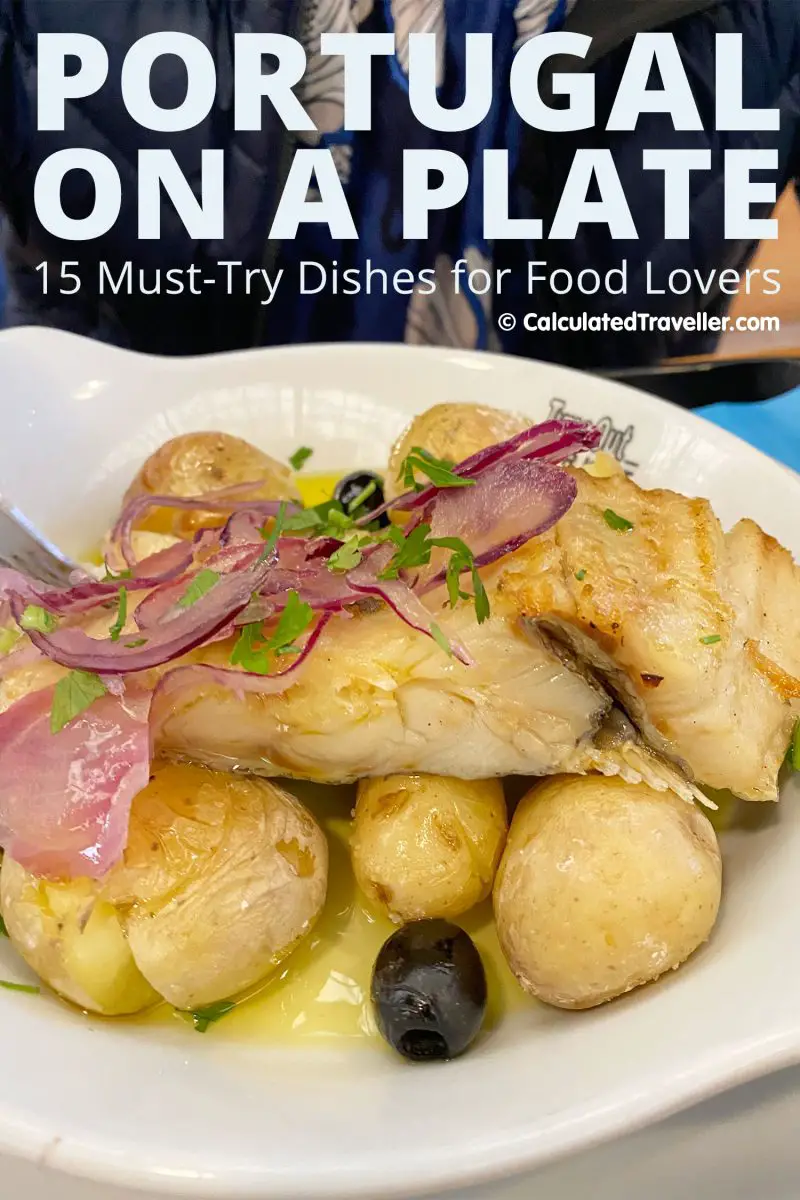
Bacalhau, salted and dried cod, is one of the most famous seafoods in Portugal. It’s one of the most common ingredients in Portuguese cooking and is in over a thousand different recipes. There are so many dishes that some say there is a dish for every single day of the year.
Some of the most popular of these dishes are bacalhau à brás, pasteis de bacalhau, and bacalhau à lagareiro. Bacalhau à brás is the most popular of the three and is served at bars as a salty side to go with beer. Pasteis de bacalhau is a cod fritter made with potato, onion, and garlic. Bacalhau à lagareiro is an oven-baked cod usually served with oil and garlic.
Polvo à Lagareiro

Another famous seafood dish in Portugal is Polvo à Lagareiro. In this dish, octopus tentacles and potatoes are boiled and served with an oil and garlic sauce. If you like octopus and garlic, you’ll love this dish.
No one knows where this dish originated from, but there are records dating back to the 16th century. This dish is most prevalent in Northern Portugal and is usually eaten on Christmas Eve.
Amêijoas à Bulhão Pato

Amêijoas, or clams, can be found all over Portugal and are cooked and prepared in hundreds of different ways. However, when given the option, a true alfacinhas (what people from Lisbon are called) will always order the amêijoas à bulhão pato.
The dish is said to have originated in the Estremadura region, particularly in or around the municipality of Almada, which is right next to Lisbon. The dish is said to have been named after the 19th-century Portuguese poet Raimundo António de Bulhão Pato, known for his love of food. He mentioned a cook in one of his writings, which is believed to have inspired the naming of the dish.
It is made with clams, white wine, garlic, and parsley. Compared to the rest of the world, it is relatively inexpensive and can be found at almost any restaurant in this nation’s capital. However, it is also found across Portugal, from the Algarve to the North. It is usually served as an appetizer but can also be a main dish.
Sardinhas Assadas
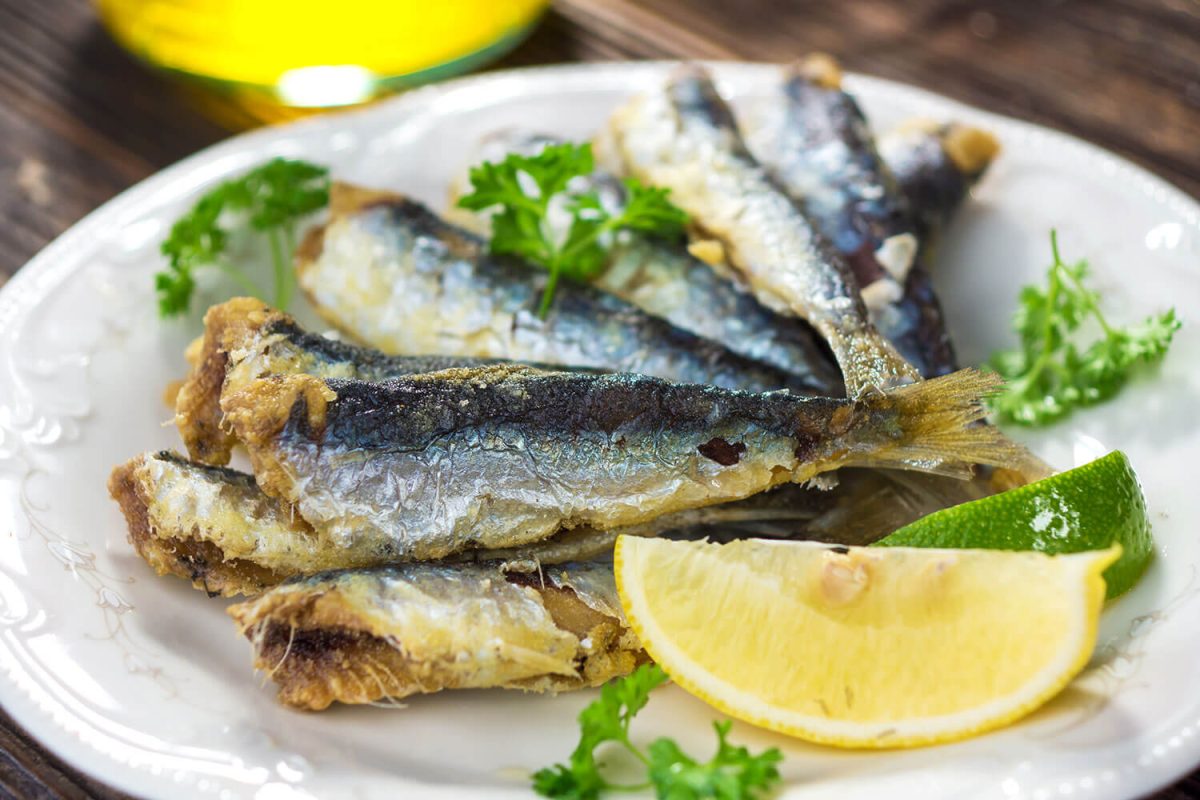
Grilled sardines are one of the best traditional meals in Portugal. They are usually eaten in the summer and are a staple of the Portuguese people. Preparation for sardines asanas is very easy. You grill sardines and add a bit of fresh lemon and a dash of sea salt.
The best time to try these salty treats is during the Festas de São João (or the Feasts of Saint John), which takes place on the night of June 23rd. They are typically eaten with a cold beer or chilled white wine and are a great source of protein.
Portuguese Food: Meat Dishes
Portuguese food is renowned for its diverse seafood dishes along the coastline, but venture inland, and you’ll discover a world where meat plays an important role in the culinary scene. In the heartland of Portugal, the cuisine shifts to celebrate the richness of land-based ingredients.
Cozido à Portuguesa
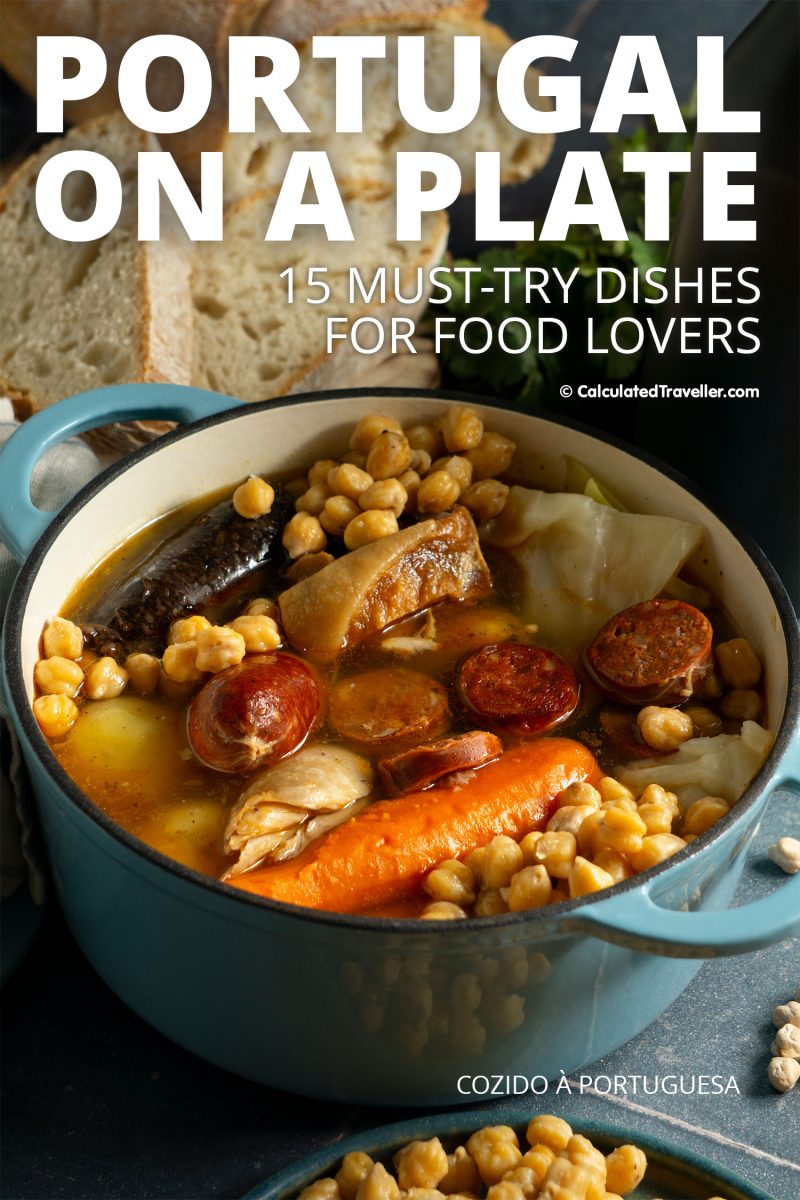
Cozido à Portuguesa is a boiled dish consisting of various meats and vegetables. This dish’s most common meats are beef, pork, chicken, and sausage. Then, there are potatoes, carrots, onions, and cabbage for the vegetables. Also, the broth of this meal is incredibly delicious when soaked up with bread.
This is considered one of Portugal’s national dishes and is served nationwide. To cook this meal, add all of your ingredients to a boiling pot of water, wait until the meat and vegetables are tender, and then you are ready to dig in.
Leitão da Bairrada
Leitão da Bairrada (or roasted pig) is one of the seven gastronomic wonders of Portugal. It’s a skewered piglet that is usually 4-6 weeks old and covered in fat and salt before being roasted over a fire. Its crisp skin and tender meat are some of the most flavorful things you will ever taste.
This dish dates back to the 1700s and comes from the Bairrada region of Portugal. It’s usually served with a side of potatoes and oranges and is only eaten on special occasions like holidays and feast days.
Francesinha
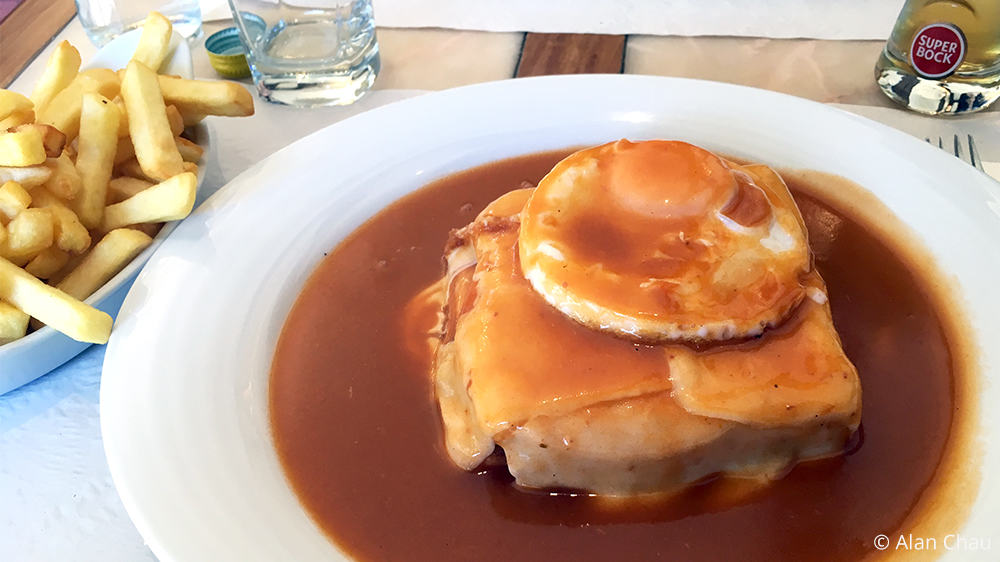
Francesinha is from Porto, Portugal, and is considered the main dish of the city. It is a sandwich made with toasted bread, ham, sausage, cheese, and steak. Then, another layer of cheese and a spicy sauce is on top of the sandwich. It’s usually served with a side of fries and an egg on top.
This delicious sandwich comes from Daniel Silva, who, after travelling to Paris in the 1950s, decided to make his own version of the famous Croque Monsieur. It quickly grew in popularity and is now a favourite of visitors and locals alike.
And if you want to try this iconic dish (and many others like it) in Porto, one of the best ways to do that is on a Porto food tour.
Chicken Piri Piri
If you are a fan of spicy food, then you’ll love this one. Chicken piri piri is made by first marinating the chicken in garlic and lemon juice. Then, a sauce, which consists of piri piri chilis, olive oil, pepper, and some cilantro, is added to the chicken. The chicken is most often barbequed but can be baked as well. It’s served with a side of salad or fries and is very delicious.
This dish is originally from Mozambique and was brought to Portugal after it was colonized. Guia is said to have the best chicken piri piri; however, you can find it in any city in Portugal.
Portuguese Food: Soups and Starters
Portuguese food is not just about seafood and meat; it also boasts a wide variety of soups and starters essential to the dining experience. Often simple yet bursting with flavours, these dishes lay the foundation for a traditional Portuguese meal.
Caldo Verde

This soup is from the Minho Region, which is in Northern Portugal. The primary ingredients of this dish are potatoes, Portuguese collard greens, sliced chorizo sausage, and spices. As a side, there will usually be Portuguese cornbread or rye bread.
This is a simple dish to prepare and can be found at weddings, birthdays, and other occasions. Even when there are no celebrations, caldo verde is eaten year-round and is the perfect dish for rainy days. It’s usually served in a traditional earthenware bowl called a tigela and tastes like Italian Wedding Soup.
Read the article: Three Reasons to Visit Portugal in the Winter
Alheira

Alheira is a Portuguese sausage made of various meats, bread, and sometimes garlic. It was invented by Portuguese Jews back in the 1400s, who couldn’t eat pork. So instead, they mixed other meats they could eat to make what is known today as Alheira. You can find this sausage at any market in Portugal, and it is one of the delicacies of Portugal.
When this sausage is served as a dish, it is usually grilled or roasted and served with a side of vegetables. It can also be served as a tapa and is accompanied by olives, cheese, and bread.
Portuguese Food: Desserts and Sweets
Most Portuguese desserts have a story behind them. Each dessert tells its own story, often connected to historical monasteries, local festivals, or family traditions, making them not just a treat for the palate but a part of Portugal’s cultural tapestry.
Pastéis de Nata
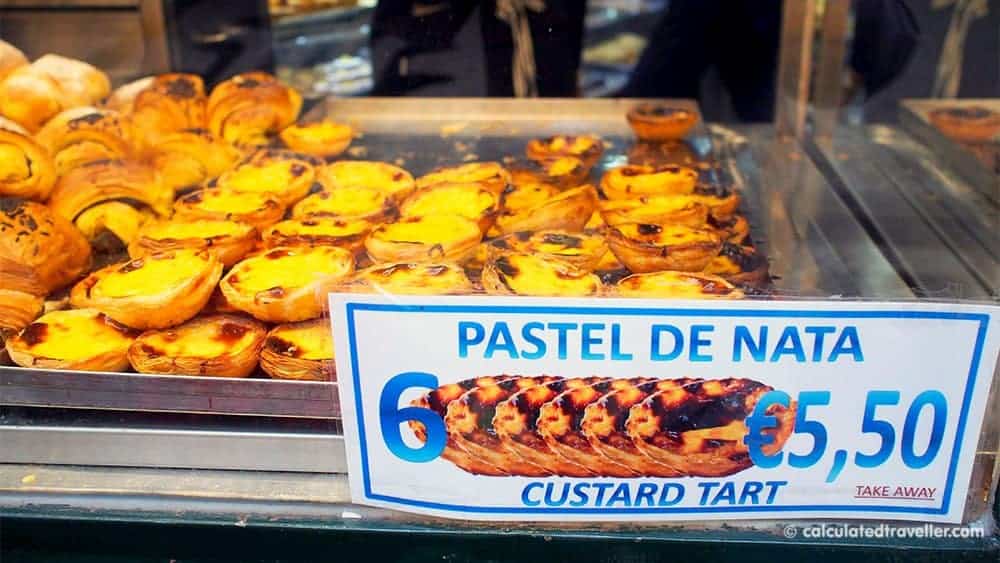
Pastéis de nata is probably the most famous dish in Portugal. If you look up what to eat in Portugal, this will always be number one on the list.
But before we get into it, let’s discuss the difference between pastel de nata and pastel de Belém. Pastel de nata is a general term for these tarts. At the same time, pastel de Belém refers to the version specifically from the Belém district of Lisbon, made using a secret recipe that dates back to the 1830s at the Jerónimos Monastery.
The monks at the monastery were using egg whites to starch clothes and didn’t know what to do with all the leftover egg yolks. They decided to make pastries with them and created pastel de Belém.
The pastel de Belém is known for its distinctive texture and flavour and is a closely guarded secret of the Fábrica de Pastéis de Belém. So when people tried to recreate the pastel de Belém but didn’t know the secret recipe, they couldn’t call it “pastel de Belém,” so they settled with “pastel de nata.”
The good news? If you visit Lisbon, you can stop by this bakery to try the original pastel de Belém. However, various shops across Portugal (and the world) also sell pastel de nata. Whichever version you try, you’ll be in for a treat.
Bolo de Berlim

The Bolo de Berlim (or Berliner) is a German donut made by frying sweet dough in oil, filling it with jam or cream, and topping it with powdered sugar. You can find them at almost any bakery in Portugal and try one for yourself.
The only differences between a German Berliner and a Portuguese Bolo de Berlim are that the Portuguese ones are slightly bigger, and you can see the cream. In contrast, with the German ones, the cream is in the donut’s center and is not visible. Also, the Portuguese cream is yolk-based, and the Berliner is just a regular vanilla cream.
Arroz Doce

This Portuguese rice pudding is made with rice, milk, sugar, eggs, lemon, cinnamon, and salt. Rice pudding can be found in almost every country in the world, and each one puts its own little spin on it. Traditional Portuguese arroz doce differs from the rest of the world because they add lemon and cinnamon.
The perfect arroz doce has a crispy outside and a soft, custard-like interior. It’s usually served chilled with the lemon and cinnamon on top. It makes for a great sweet treat after a salty Portuguese dinner.
Drinks and Beverages in Portugal
And what about Portuguese drinks? Each drink, whether it be wine, liqueur, or a non-alcoholic option, carries with it a piece of Portuguese culture and tradition, making them more than just a complement to meals but a taste of the country’s heritage.
Port Wine

Port Wine is from the Douro Valley in Northern Portugal. This wine is made from a blend of grapes and is known for its sweet flavour. Port wine is usually served either with dessert or as a dessert on its own.
This wine is not only the most famous but also the oldest in Portugal. The Douro Valley is the oldest demarcated wine region in the world, dating back to 1775. Port Wine is most famously a red wine but can also be a white or rosé. If you want to try this wine at the source, head to the Douro Valley and book a wine-tasting tour.
Ginja
Last on this list is Ginja. This Portuguese alcohol is made from an anise-flavoured liqueur called aguardiente and infused with ganja berries (or sour cherries). Then add some sugar and a little salt, and you have Ginja.
Ginja is available throughout Portugal but mainly in the Oeste and Lisbon regions. It originated in Lisbon, and if you want, you can go to the bar that first served it, A Ginjinha. This bar opened in 1840 and has been in the same family for five generations.
Final Thoughts: The Best Portuguese Dishes
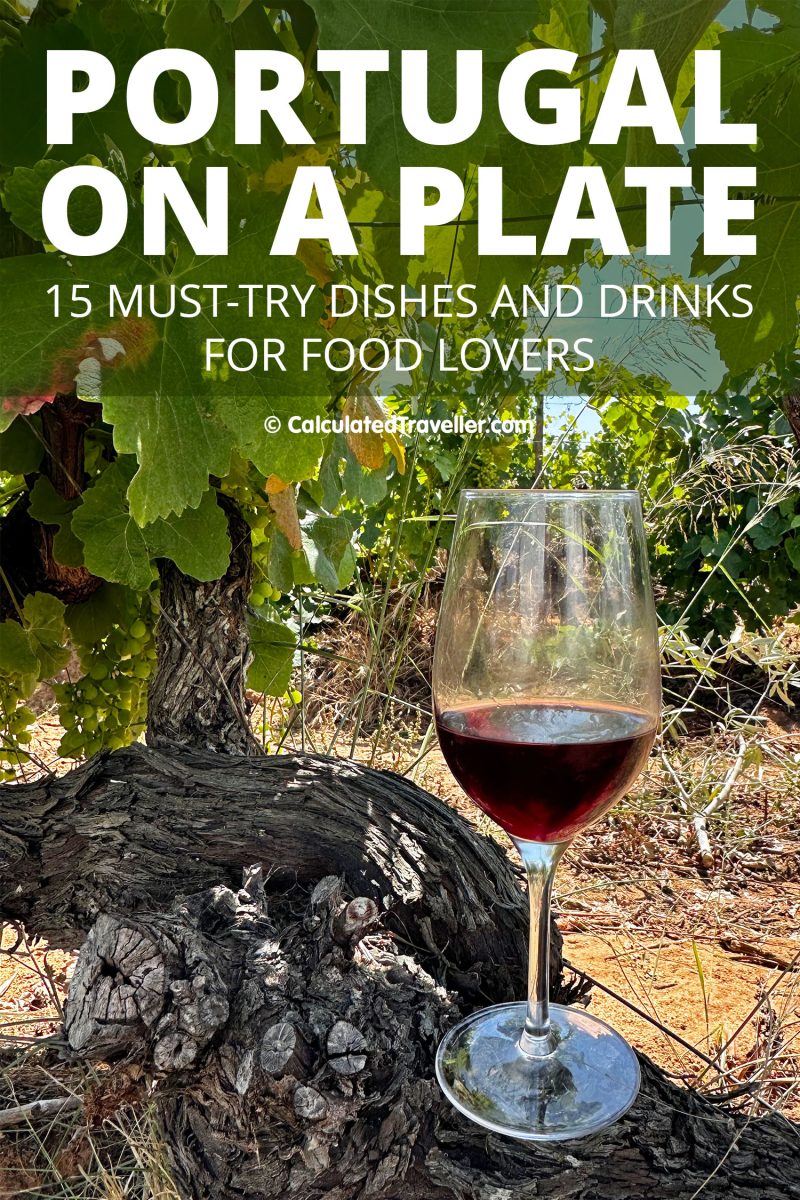
As we conclude our food tour of Portugal, it’s obvious that Portuguese cuisine is more than just food; it’s a celebration of culture, history, and communal joy.
Each dish we’ve explored offers a unique glimpse into the heart and soul of Portugal – from the communal cozido, bringing families together, to the sweet, nostalgic flavours of pastéis de nata.
So, whether you savour these delights in a bustling Lisbon eatery or cook them in your kitchen, remember that each bite is a journey through the rich tapestry of Portugal’s culinary heritage. Bom appetite!
Guest author Yvonne is a Canadian who calls Portugal home (at least part-time). She’s been living in the country since 2020. She owns a small house in rural Portugal and loves to write about Portugal travel on her blog, nowinportugal.com.

